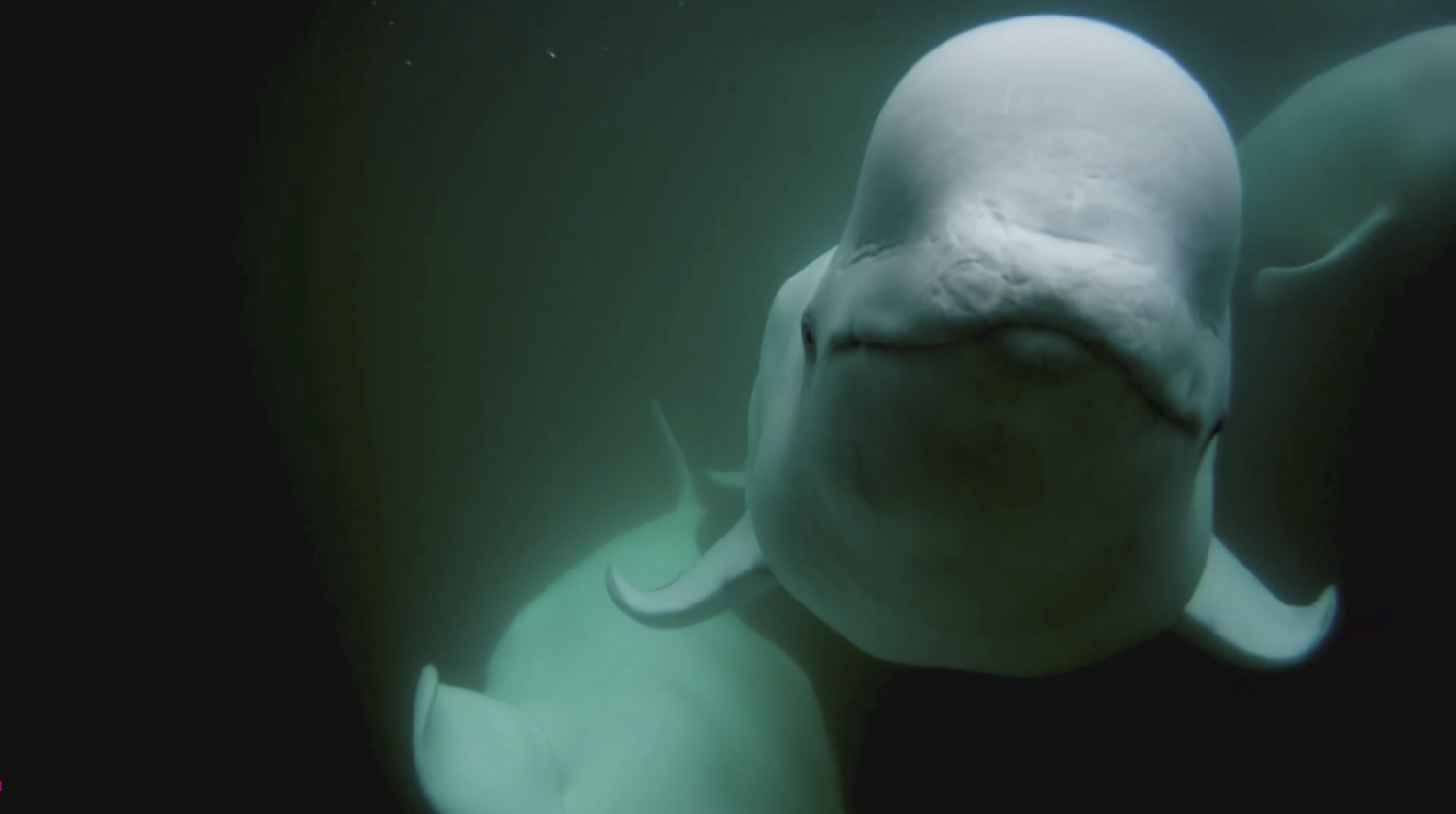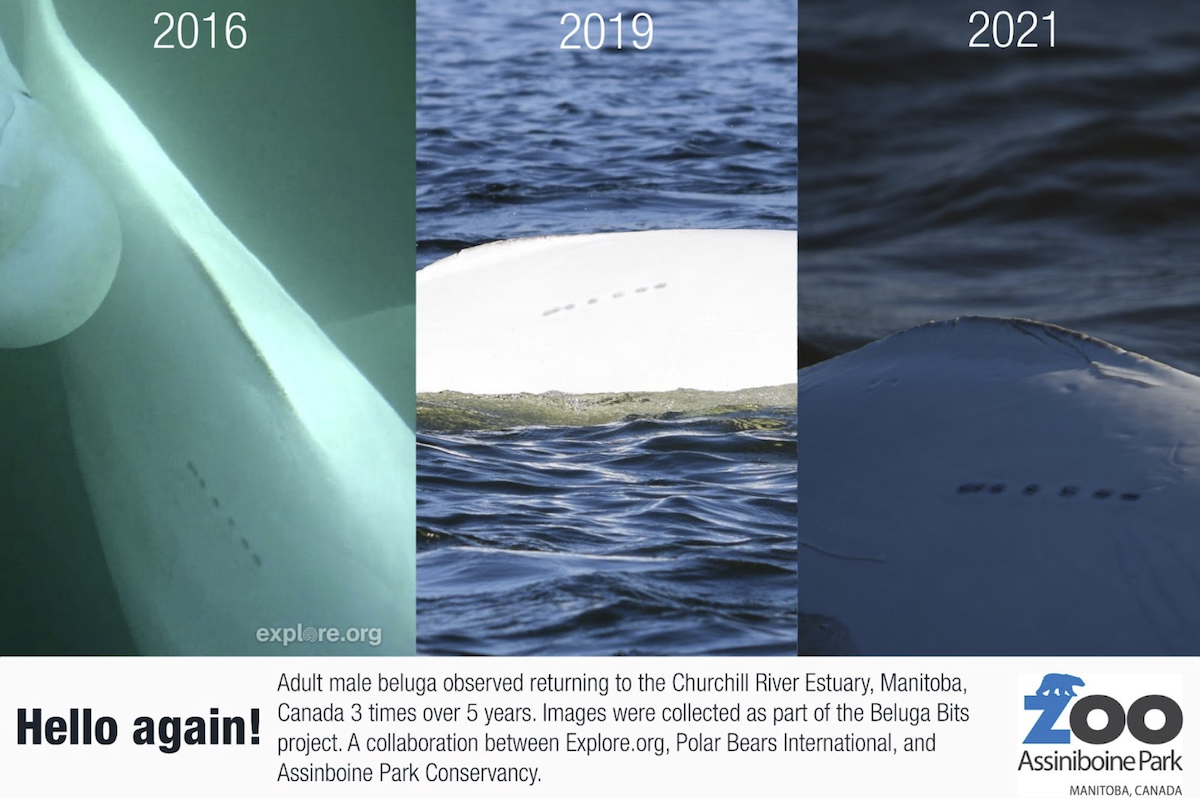Every summer, we partner with Explore.org to bring viewers an immersive and inspiring view into the underwater world of beluga whales—a beloved seasonal visitor to the Churchill River estuary that flows near our unique home base in Churchill, Manitoba. The outreach is part of our goal to inspire people to care about the Arctic ecosystem.
Sea ice in the Arctic is so important for belugas because they are highly adapted to life in and around ice. We see them in Churchill during the summer ice-free season, but for most of the year these whales live in areas of heavy ice cover. One of the hypotheses as to why thousands of belugas are found in the rivers of Hudson Bay in the summer is that ice cover provides protection from killer whales; without it, they need to retreat to areas like rivers, which may be too shallow for orcas. Sea ice also forms the base of the food chain for many beluga populations. While belugas are near the top of the food web, they rely on algae, zooplankton, and fishes that are parts of the Arctic ecosystem.
For the past six years, we’ve teamed up with the Assiniboine Park Zoo on a citizen science project that relies on video from the Beluga Cam. The collaborative research project, called Beluga Bits, gives viewers the opportunity to actively participate in the classification and identification of belugas.
There are two ways that folks who are passionate about belugas and the ocean can get involved and encounter these whales virtually. The first is to collect snapshots of belugas from the Explore.org Beluga Cam in July and August. The second way is to help classify the images on the Beluga Bits project, found here. The workflows on Beluga Bits sometimes change to reflect different research interests, but many involve identifying the beluga’s orientation (e.g., can you see its underside?), what parts of the beluga are visible, and distinguishing markings on the belugas themselves.
We caught up with Dr. Stephen Petersen of the Assiniboine Park Zoo, which is part of our Arctic Ambassador Center network, to get an update on the project and developments!

Can you remind us of how Beluga Bits began?
Like many projects, Beluga Bits started with a lot of questions about beluga whales followed by putting the pieces together to make it work. I had been studying belugas and other Arctic marine mammals for a few years and happened to be working on another project in Churchill with Meagan Hainstock looking at beluga behavior. While we were out on the water, we would get these tantalizing glimpses of belugas who had scars and marks that we thought could be used for photo identification, a common way to study other whales non-invasively.
Typically, with other whale species, you can use markings on the dorsal fins or the contrast of their body color with scarring to help identify them. Belugas on the other hand are much harder to identify given that they don’t have dorsal fins and are white as adults. While we were in Churchill and chatting with colleagues at Polar Bears International, we were introduced to the Beluga Cam.
It didn’t take very long watching the live stream to realize that this could be an amazing data source for capturing the full bodies of beluga whales underwater. In fact, we realized we could often see a lot more than just the individual marks—because the beluga would often swim upside down, we could see their “bits” and determine if they were male or female, and thus Beluga Bits was born. It still took a couple of years to get to where we are today with the Explore.org community collecting snapshots that we then use in our Zooniverse.org project to get folks from around the world to help with classification.
In what ways has the project developed in the six years it’s been running?
Our project has grown in scope every year since 2016. On Beluga Bits, we now have over 22,000 registered participants who have completed nearly 5 million classifications! There have been upgrades and changes to almost every aspect of the project. Our longstanding partnership with Polar Bears International has ensured incredible video footage every year, but they have also been able to expand video collection to other parts of Western Hudson Bay in addition to the in-estuary footage. An exciting development we have incorporated recently is the use of artificial intelligence, specifically machine learning, to help remove photos without belugas before uploading. Too many photos of just water are not that fun for participants to sort through and AI can quickly do this boring task. We partnered with a computer science professor and a student at the University of Manitoba to create an algorithm that can automatically detect frames that contain belugas, and those that do not. We used this algorithm for our 2021 photos to pre-sort images that were ultimately uploaded to Beluga Bits.
Are there any new research questions your team are pursuing?
One cool development has been the need to develop a workflow dedicated to jellies and jellyfish species in the estuary. Many of our participants started pointing out interesting jellyfish in the beluga images so we wanted to explore these species further. This workflow started with three species we knew of, the moon jellyfish, the lion’s mane jellyfish, and the Arctic comb jelly. However participants quickly started pointing out other individuals that looked different. We now have been able to confirm five species in the estuary, adding the melon comb jelly and the common northern comb jelly to our list. We are particularly interested in monitoring jelly and jellyfish populations as these species can be indicators of ecosystem change in ocean habitats. As the Arctic ocean warms and there is increasing ship traffic, we may start to see new species of jellies and jellyfish appear in this environment. It’s important that we monitor these species as they may provide greater insights into the ecosystem and emerging threats.

Can you share some results you’ve had from the project?
We have had some awesome breakthroughs in the project thanks to the help of citizen scientists! We have been able to resight two different whales now based on unique marks seen in our photo dataset. One whale (shown in the photo below) has a series of dot-like marks on the side of its dorsal ridge. This whale was resighted in 2021, the third year it has been spotted. Similarly, we had another resighting in 2021 of a whale with a large scar across its melon that was originally seen in 2017. These resightings are so important because we can start to paint a picture of what whales are returning to the estuary, how frequently, and how they are healing!
How does the data from this project inform conservation efforts?
It is typically very expensive to monitor Arctic marine mammals like belugas (and polar bears), but we hope that over time this project will help in the monitoring of this population to detect threats and management action can be put in place before numbers decline. Western Hudson Bay is also being evaluated as a possible National Marine Conservation Area (NMCA) and information about the species that inhabit the ecosystem are vital to getting this designation. NMCAs are established to regulate activity, use, and protect the species and habitats within them. We are hoping that information from the Beluga Bits program will help inform managers when making this important decision.
Are belugas impacted by climate change? If yes, how?
That is a great question without an easy answer. We know belugas are Arctic-adapted species so if the habitat becomes less like the Arctic they will face increased pressures. We also know that belugas are found farther south than Churchill in places like the St. Lawrence River in eastern Canada. These belugas are not doing very well and are listed as endangered but we are not sure how much of that is climate related and how much is due to other human activities. We suspect that as the habitat changes due to climate warming, belugas will face increasing threats as prey distribution and abundance changes, as the ocean becomes more acidic and noisy, and as people expand their activities. Ultimately, beluga populations are only found in places with seasonal sea ice so reductions in this habitat will not benefit beluga.
Is there anything else you wanted to say about the project?
We wanted to say a massive thank you to everyone who has contributed to the project over the years! Whether it’s contributing classifications on Beluga Bits, or taking snapshots on the explore.org livestream, these data are so important to our project and it allows us to explore so many interesting and vital research avenues. We genuinely couldn’t do it without you!

















